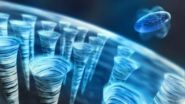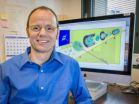(Press-News.org) Liquid helium, when cooled down nearly to absolute zero, exhibits unusual properties that scientists have struggled to understand: it creeps up walls and flows freely through impossibly small channels, completely lacking viscosity. It becomes a new state of matter – a "superfluid."
Now, a large, international team of researchers led by scientists at USC, Stanford and Berkeley has used X-rays from a free-electron laser to peer inside individual droplets of liquid helium, exploring whether this liquid helium retains its superfluid characteristics even at microscopic scales – such as in tiny droplets of helium mist.
"One of the ways that superfluidity manifests is through the formation of quantum vortices, but they have never been experimentally observed in droplets," said Andrey Vilesov, professor of chemistry and physics at the USC Dornsife Collge of Letters, Arts and Sciences and co-corresponding author of the study, which appears in Science on August 22.
Vilesov's co-corresponding authors include Christoph Bostedt, senior staff scientist at the SLAC National Accelerator Laboratory, and Oliver Gessner of the Lawrence Berkeley National Laboratory.
The team found that quantum vortices, or whirlpools, form in spinning helium nanodroplets in unprecedented quantities, leading to extreme deformation of the droplets into flat discs that resemble a thick pancake. In addition, the group also noticed anomalously large numbers of vortices in the droplets, indicating they even behave differently than other superfluids.
"Now we are able to study this form of matter in a new way that allows us to see how quantum mechanics manifests itself in the motion of an isolated superfluid," Gessner said.
If a drop of normal liquid spins, centrifugal force pushes the liquid away from the center, leading to equatorial and polar deformation – much like the way the spinning of the earth makes it deviate slightly from a perfect sphere. If a planet spins fast enough, it distorts into a peanut shape before flying apart, unable to sustain the strain of its own motion.
Spinning superfluid helium similarly distorts its shape, but also forms a honeycomb consisting of countless quantum vortices, in contrast to the single vortex formed in a normal liquid. The lack of viscosity in the superfluid allows these vortices to persist indefinitely.
As such, in a superfluid droplet, the rotation is evenly distributed in vortices, which allows the droplet to withstand stunningly large rotation speeds without forming lobes or disintegrating.
"Even though it is a liquid, there's a higher degree of order — and we were able to image that. It's far beyond what people originally thought free electron lasers were able to do," Bostedt said.
Some speculate that studying superfluids could help understand the origins of the universe; in the moments following the Big Bang, the universe was uniform in density and similar to a superfluid. The creation of density fluctuations in the form of quantum vortices may be what led to the early formation of galaxies.
"A cosmos hides within each helium droplet, and we looked inside over 10,000 of them," said Curtis Jones, USC graduate student.
Vilesov and his colleagues also plan to study how the presence of quantum vortices affects chemical reactions and cluster formation inside helium nanodroplets.
INFORMATION:
This research was funded by the National Science Foundation (grant CHE-1112391), the U.S. Department of Energy (Contract No. DE-AC02-05CH11231), and the Max Planck Society.
New properties of rotating superfluids discovered in helium nanodroplets
Scientists use giant laser to examine frigid droplets of liquid helium that stretch the imagination and defy intuition
2014-08-21
ELSE PRESS RELEASES FROM THIS DATE:
Severe drought is causing the western US to rise
2014-08-21
The severe drought gripping the western United States in recent years is changing the landscape well beyond localized effects of water restrictions and browning lawns. Scientists at Scripps Institution of Oceanography at UC San Diego have now discovered that the growing, broad-scale loss of water is causing the entire western U.S. to rise up like an uncoiled spring.
Investigating ground positioning data from GPS stations throughout the west, Scripps researchers Adrian Borsa, Duncan Agnew, and Dan Cayan found that the water shortage is causing an "uplift" effect up to ...
X-ray laser probes tiny quantum tornadoes in superfluid droplets
2014-08-21
An experiment at the Department of Energy's SLAC National Accelerator Laboratory revealed a well-organized 3-D grid of quantum "tornadoes" inside microscopic droplets of supercooled liquid helium – the first time this formation has been seen at such a tiny scale.
The findings by an international research team provide new insight on the strange nanoscale traits of a so-called "superfluid" state of liquid helium. When chilled to extremes, liquid helium behaves according to the rules of quantum mechanics that apply to matter at the smallest scales and defy the laws of classical ...
Researchers map quantum vortices inside superfluid helium nanodroplets
2014-08-21
Scientists have, for the first time, characterized so-called quantum vortices that swirl within tiny droplets of liquid helium. The research, led by scientists at the U.S. Department of Energy's Lawrence Berkeley National Laboratory (Berkeley Lab), the University of Southern California, and SLAC National Accelerator Laboratory, confirms that helium nanodroplets are in fact the smallest possible superfluidic objects and opens new avenues to study quantum rotation.
"The observation of quantum vortices is one of the most clear and unique demonstrations of the quantum properties ...
Sunlight, not microbes, key to CO2 in Arctic
2014-08-21
CORVALLIS, Ore. – The vast reservoir of carbon stored in Arctic permafrost is gradually being converted to carbon dioxide (CO2) after entering the freshwater system in a process thought to be controlled largely by microbial activity.
However, a new study – funded by the National Science Foundation and published this week in the journal Science – concludes that sunlight and not bacteria is the key to triggering the production of CO2 from material released by Arctic soils.
The finding is particularly important, scientists say, because climate change could affect when ...
A novel 'man and machine' decision support system makes malaria diagnostics more effective
2014-08-21
A Finnish-Swedish research group at the Institute for Molecular Medicine Finland (FIMM), University of Helsinki, and Karolinska institutet, Stockholm, has developed a novel "man and machine" decision support system for diagnosing malaria infection. This innovative diagnostic aid was described in PLOS One scientific journal today, 21 August. The method is based on computer vision algorithms similar to those used in facial recognition systems combined with visualization of only the diagnostically most relevant areas. Tablet computers can be utilized in viewing the images.
In ...
Scientists observe quantum vortices in cold helium droplets
2014-08-21
An international research team including DESY scientists has observed tiny quantum vortices in cold droplets of liquid helium. The team reports in the journal Science that the exotic vortices arrange themselves as densely packed lattices inside the nanodroplets. It is the first time that the quantum vortices, which have already been observed in larger samples of what is known as superfluid helium, have been detected in nanodroplets. "The experiment has exceeded our best expectations," says Andrey Vilesov of the University of Southern California, one of the experiment's ...
Hot-spring bacteria reveal ability to use far-red light for photosynthesis
2014-08-21
Bacteria growing in near darkness use a previously unknown process for harvesting energy and producing oxygen from sunlight, a research team led by a Penn State University scientist has discovered. The discovery lays the foundation for further research aimed at improving plant growth, harvesting energy from the Sun, and understanding dense blooms like those now occurring on Lake Erie and other lakes worldwide. A paper describing the discovery will be published in the Science Express edition of the journal Science on 21 August 2014.
"We have shown that some cyanobacteria, ...
New DNA test for diagnosing diseases linked to childhood blindness
2014-08-21
SAN FRANCISCO – Aug. 21, 2014 – Researchers in the United Kingdom have demonstrated that advanced DNA testing for congenital cataracts can quickly and accurately diagnose a number of rare diseases marked by childhood blindness, according to a study published online today in Ophthalmology, the journal of the American Academy of Ophthalmology. Using a single test, doctors were able to tailor care specifically to a child's condition based on their mutations reducing the time and money spent on diagnosis and enabling earlier treatment and genetic counseling.
Each year, ...
USC Eye Institute study shows Native American ancestry a risk factor for eye disease
2014-08-21
LOS ANGELES — New research led by the University of Southern California (USC) Eye Institute, part of Keck Medicine of USC, shows for the first time that Native American ancestry is a significant risk factor for vision-threatening diabetic retinopathy among Latinos with Type 2 diabetes. Diabetic retinopathy is the leading cause of blindness in working-age adults in the United States, affecting more than 4 million Americans age 40 and older.
The research was published online today in Investigative Ophthalmology & Visual Science, the peer-reviewed academic journal of The ...
Novel recycling methods: The fluorescent fingerprint of plastics
2014-08-21
Researchers at Ludwig-Maximilians-Universitaet (LMU) in Munich have developed a new process which will greatly simplify the process of sorting plastics in recycling plants. The method enables automated identification of polymers, facilitating rapid separation of plastics for re-use.
A team of researchers led by Professor Heinz Langhals of LMU's Department of Chemistry has taken a significant step which promises to markedly expedite the recycling of plastic waste. They have developed a technique which provides for automated recognition of their polymer constituents, thus ...
LAST 30 PRESS RELEASES:
University of Oklahoma researcher awarded funding to pursue AI-powered material design
Exploring how the visual system recovers following injury
Support for parents with infants at pediatric check-ups leads to better reading and math skills in elementary school
Kids’ behavioral health is a growing share of family health costs
Day & night: Cancer disrupts the brain’s natural rhythm
COVID-19 vaccination significantly reduces risk to pregnant women and baby
The role of vaccination in maternal and perinatal outcomes associated with COVID-19 in pregnancy
Mayo Clinic smartwatch system helps parents shorten and defuse children's severe tantrums early
Behavioral health spending spikes to 40% of all children’s health expenditures, nearly doubling in a decade
Digital cognitive behavioral treatment for generalized anxiety disorder
Expenditures for pediatric behavioral health care over time and estimated family financial burden
Air conditioning in nursing homes and mortality during extreme heat
The Alps to lose a record number of glaciers in the next decade
What makes a good proton conductor?
New science reporting guide published for journalists in Bulgaria
New international study reveals major survival gaps among children with cancer
New science reporting guide published for journalists in Turkey
Scientists develop a smarter mRNA therapy that knows which cells to target
Neuroanatomy-informed brain–machine hybrid intelligence for robust acoustic target detection
Eight SwRI hydrogen projects funded by ENERGYWERX
The Lundquist Institute and its start-up company Vitalex Biosciences Announces Strategic Advancement of Second-Generation fungal Vaccine VXV-01 through Phase 1 Trials under $40 Million Competitive Con
Fine particles in pollution are associated with early signs of autoimmune disease
Review article | Towards a Global Ground-Based Earth Observatory (GGBEO): Leveraging existing systems and networks
Penn and UMich create world’s smallest programmable, autonomous robots
Cleveland researchers launch first major study to address ‘hidden performance killer’ in athletes
To connect across politics, try saying what you oppose
Modulating key interaction prevents virus from entering cells
Project explores barriers to NHS career progression facing international medical graduates
Jeonbuk National University researchers explore the impact of different seasonings on the flavor perception of Doenjang soup
Two Keck Medicine of USC Hospitals named Leapfrog Top Teaching Hospitals
[Press-News.org] New properties of rotating superfluids discovered in helium nanodropletsScientists use giant laser to examine frigid droplets of liquid helium that stretch the imagination and defy intuition




